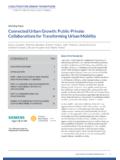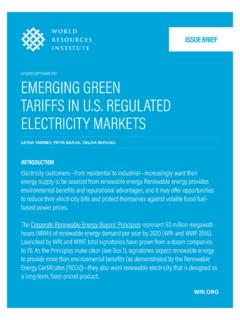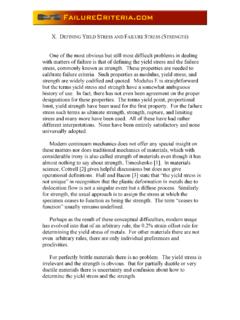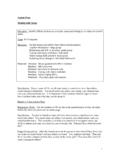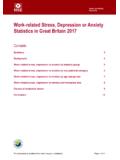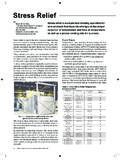Transcription of AQUEDUCT PROJECTED WATER STRESS COUNTRY …
1 TECHNICAL NOTE. AQUEDUCT PROJECTED WATER STRESS . COUNTRY RANKINGS. BY TIANYI LUO, ROBERT YOUNG, AND PAUL REIG. EXECUTIVE SUMMARY. Changes in climate, economic development, urbaniza- CONTENTS. tion, and population growth will impact WATER availability Executive 1. around the world. To prepare for these changes, decision- 2. makers need to consider future scenarios of global WATER supply and demand. Investors, policymakers, companies, 3. and development organizations can use such PROJECTED 4. estimates to quantify future impact, hedge risks, and 4. adapt to changes at relevant scales. For certain decisions and analysis, the national scale may be important, and to the best of our knowledge, no up-to-date, COUNTRY -level projections currently exist in the public domain. Technical notes document the research or analytical WRI's AQUEDUCT WATER STRESS Projections,1 released in methodology underpinning a publication, interactive June, 2015, allow users to analyze different future demand application, or tool.
2 And supply scenarios at a sub-catchment level, based on the latest data from the Intergovernmental Panel on Suggested Citation: Luo, T., R. Young, P. Reig. 2015. AQUEDUCT Climate Change (IPCC) 5th Assessment Report (AR5). PROJECTED WATER STRESS COUNTRY Rankings. Technical Note. In the current analysis, we utilize a spatial aggregation Washington, : World Resources Institute. Available online methodology2 to bring the sub-catchment scale AQUEDUCT at: COUNTRY -rankings WATER STRESS Projections up to the COUNTRY scale. These global COUNTRY -level projections are best suited to making comparisons among countries for the same year, as well as among decades and scenarios for the same region. As with AQUEDUCT 's previous projections and coun- try rankings, these COUNTRY -level future scenarios might not be as accurate as those using higher resolution data or more localized scenarios.
3 These indicators also should not be seen as predictions, but rather as potential outcomes under specific climate and socio-economic trajectories, which are subject to uncertainties. Nor do the indicators attempt to account for existing governance and invest- TECHNICAL NOTE | August 2015 | 1. ment in the WATER sector. These COUNTRY -level WATER STRESS Box 1 | IPCC Scenarios projections are intended to provide useful information about potential future WATER situations that can help drive improved WATER management at the international scale. The scenarios in this report are based on a combination of rep- The full results of all scenarios are available at: http:// resentative concentration pathways and shared socio-economic pathways from IPCC 5th Assessment Report, which are used to project estimates of future WATER supply and demand.
4 WATER - STRESS - COUNTRY -rankings. REPRESENTATIVE CONCENTRATION PATHWAYS. (RCPS) are scenarios of the increase in radiative forcing INTRODUCTION through 2100. These drive the climate factors in the General This analysis follows the methodology used in Gassert et Circulation Models from CMIP5. to calculate COUNTRY rankings of baseline WATER STRESS , seasonal and inter-annual variability, flood occurrence, and is a business-as-usual scenario of relatively unconstrained emissions. Temperatures increase . drought severity for the year 2010. We employ a spatially C by 2100 relative to 1986 2005 levels. weighted aggregation methodology that brings AQUEDUCT 's sub-catchment risk estimates up to the COUNTRY scale. This represents a cautiously optimistic scenario. Temperatures rise C by 2100. method generates rankings of WATER STRESS and other indica- tors for all WATER users as well as sector-specific rankings SHARED SOCIOECONOMIC PATHWAYS (SSPS) are for agricultural, domestic, and industrial users.
5 Scenarios of socioeconomic drivers. AQUEDUCT 's COUNTRY -level indicators are valuable when it SSP2 is a business-as-usual scenario. comes to national risk benchmarking and comparison, and SSP3 is a pessimistic scenario with higher population growth, lower GDP growth, and a lower rate of urbaniza- have already proven their usability through their incor- tion. poration into the evaluation models of companies like MSCI Inc., and analyses and databases of organizations These pathways were combined into overall optimistic . like the World Economic Forum and FAO (AQUASTAT). ( and SSP2), business-as-usual ( and SSP2), International organizations and financial institutions and pessimistic ( and SSP3) scenarios. also need such indicators, because many WATER -related Source: Luck, M., M. Landis, F. Gassert. 2015. AQUEDUCT WATER STRESS political, international aid, and investment decisions are Projections: Decadal Projections of WATER Supply and Demand Using made across political or administrative By CMIP5 GCMs.
6 Technical Note. Washington, : World Resources Institute. Available online at: aggregating these data to the national level, the indicators WATER - STRESS -projections. bridge this gap, enabling investors to consider WATER STRESS across their entire portfolio, and other users to make consistent comparisons across multiple countries at the same time. They provide estimates of WATER STRESS , demand, supply, While the Gassert et al. COUNTRY rankings provide informa- and seasonal variability for the years 2020, 2030, and tion on current WATER risk, there is a growing demand for 2040, targeted toward decadal scale planning, adapta- information that projects future global WATER supply and tion, and The projections in the current paper demand scenarios. Both private and public sectors see the are based on the AQUEDUCT framework, and account for need to plan for potential changes in WATER availability upstream-downstream interactions and spatial relation- caused by climate change and economic development in ships between human activities and WATER the coming The resulting COUNTRY WATER STRESS projections include In this analysis, we calculate PROJECTED WATER STRESS infor- thirty-six datasets that look at three time periods 2020, mation for countries from the sub-catchment scale Aque- 2030, and 2040 and three combined climate and socio- duct WATER STRESS Projections.
7 WRI's AQUEDUCT WATER economic scenarios optimistic, business-as-usual, and STRESS Projections, released in June 2015, are based on the pessimistic (Box 1) from IPCC. Total WATER STRESS levels latest data from the Intergovernmental Panel on Climate for each COUNTRY are provided, along with WATER STRESS Change (IPCC), and allow users to analyze different future exposed by domestic, industrial, and agricultural sectors. demand and supply scenarios at a sub-catchment level. 2 |. AQUEDUCT PROJECTED WATER - STRESS COUNTRY RANKINGS. We hope that these datasets, which take into account the Table 1 | AQUEDUCT WATER STRESS Thresholds relative impact of climate and socio-economic changes on WATER availability, can help international organizations, businesses, and financial institutions to take steps to miti- CATEGORY SCORE. RATIO OF WITHDRAWALS TO.
8 AVAILABLE WATER (PERCENT). gate risks and more effectively adapt to plausible future climate change and WATER demand scenarios. Low 0 1 <10. METHODOLOGY Low to medium 1 2 10 20. We followed the aggregation method in Gassert et al., Medium to high 2 3 20 40. 2013, which took three spatially explicit inputs (Fig- High 3 4 40 80. ure 1) source indicators, gridded weights, and target regions and calculated a spatially weighted average of Extremely high 4 5 >80. source-indicator values for each target region. For each scenario under each future year, WATER STRESS was used as the source indicator. WATER STRESS is defined as the ratio For example, the domestic WATER withdrawals datasets between total WATER withdrawals and available renewable identify areas where households and others drawing from surface WATER at a sub-catchment level.
9 Higher scores on municipal sources are PROJECTED to use WATER ; these data the scale from 0 to 5 correspond to greater competition are used as a weight to measure the exposure of domestic among WATER users relative to available surface WATER WATER users to WATER STRESS . Thus, COUNTRY -level baseline resources (Table 1). WATER STRESS , weighted by domestic withdrawals, can be interpreted to show which countries have the most or least Gridded WATER -withdrawal datasets were chosen as weights stressed domestic sectors. The same approach is used for because they indicate where human demand for WATER is agricultural and industrial withdrawals. the highest. This technique gives greater weight to the areas where socioeconomic dependency on WATER resources is Within each target region, values of the source indicators most critical.
10 Gridded withdrawals were further divided were resampled into grids to match the cell size of weight- into three sectors (agricultural, domestic, and industrial) to ing grids. The weighted average (sr) was then computed allow us to measure each sector's exposure to WATER STRESS . by multiplying the resampled source indicator grids (sp). Figure 1 | ource Indicators WATER STRESS (A), Gridded Weights Withdrawal Distribution (B), S. and Target Regions Countries (C). C. B. A. TECHNICAL NOTE | August 2015 | 3. by the weighting grids (wp), summing, and dividing by the Information of this type can be used by private and public sum of the weighting grids across the target region (r). sector decision-makers to quantify the impacts of poten- tial future climate and socio-economic changes on WATER resources and competition. Our weighted aggregation methodology brings AQUEDUCT 's WATER STRESS projections to the COUNTRY scale while retaining the detail and geospatial sensitivity of the underlying data.
